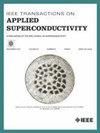Toward a Reduced Helium Content Cryogenic Cooling Scheme at 4.5 K for CERN’s FCC-hh Accelerator
IF 1.8
3区 物理与天体物理
Q3 ENGINEERING, ELECTRICAL & ELECTRONIC
引用次数: 0
Abstract
A conceptual design for cooling superconducting accelerator magnets operating at 4.5 K is proposed for the hadron-hadron configuration of the Future Circular Collider (FCC-hh). This is motivated by efforts to reduce helium inventory and energy costs, while ensuring compatibility with the tunnel structure envisaged for FCC-ee, and providing a technically viable solution for the magnets. The study is carried out for the latest configuration of the FCC-hh machine, the so-called F14 scenario, that uses Nb欧洲核子研究中心FCC-hh加速器4.5 K低氦含量低温冷却方案
提出了一种用于未来圆形对撞机(FCC-hh)强子-强子配置的4.5 K超导加速器磁体冷却的概念设计。这是为了减少氦气库存和能源成本,同时确保与FCC-ee设想的隧道结构的兼容性,并为磁体提供技术上可行的解决方案。这项研究是针对FCC-hh机器的最新配置进行的,即所谓的F14方案,该方案使用Nb$_{3}$Sn超导磁体,工作磁场为14 T,质心能量为85 TeV,磁填充方案为83%。给出了更新后的热负荷,以及磁铁结构中预期的纵向和径向温度梯度。从广泛使用He II的1.9 K操作转向使用单相氦气的4.5 K操作,显着降低了30%的整体低温功耗,机器的氦气库存降低了50%。
本文章由计算机程序翻译,如有差异,请以英文原文为准。
求助全文
约1分钟内获得全文
求助全文
来源期刊

IEEE Transactions on Applied Superconductivity
工程技术-工程:电子与电气
CiteScore
3.50
自引率
33.30%
发文量
650
审稿时长
2.3 months
期刊介绍:
IEEE Transactions on Applied Superconductivity (TAS) contains articles on the applications of superconductivity and other relevant technology. Electronic applications include analog and digital circuits employing thin films and active devices such as Josephson junctions. Large scale applications include magnets for power applications such as motors and generators, for magnetic resonance, for accelerators, and cable applications such as power transmission.
 求助内容:
求助内容: 应助结果提醒方式:
应助结果提醒方式:


